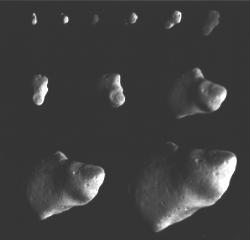

Note: Click on Solar System Exploration: Galileo Legacy Site (NASA-JPL) to get this image at its highest resolution.
This montage of 11 images shows Gaspra growing progressively larger in the
field of view of Galileo's camera. Asteroid Gaspra rotates once in 7 hours,
3 minutes and counterclockwise when viewed from above the north pole -
these images cover almost one Gaspra "day". Many craters are visible on the
surface of Gaspra.
The earliest view (upper left) was taken 5 3/4 hours before closest approach
from a range of 164,000 kilometers (102,000 miles).
Galileo's flyby of the asteroid Gaspra marked the first ever spacecraft
encounter with an asteroid.
The last view (lower right) was taken at a range of 16,000 kilometers
(10,000 miles), 30 minutes before closest approach.
From ground-based observations, quite a bit of information was known about
Gaspra before the encounter.
Discovered in 1916 by astronomer Grigori Neujmin at Simeis Observatory in
the Ukraine, Gaspra was named for a scientists' resort on the Crimean
Peninsula.
Gaspra, an S-type (or stony) asteroid, is believed to be made up of metallic
and rocky minerals including iron, nickel, olivine, and pyroxene.
This asteroid is just one of more than 15,000 asteroids comprising the
"main belt" - a large doughnut-shaped region midway between Mars and
Jupiter.
Gaspra is located about 331 million kilometers (206 million miles) from the
Sun, near the inner edge of the main belt.
Asteroids are also known as minor planets; many are much larger than Gaspra,
ranging up to more than 1,000 kilometers (600 miles) in diameter.
Investigating asteroids like Gaspra and Ida is important to scientists
because asteroids contain important clues to processes in the early solar
system.
Asteroids are believed to have formed during the earliest stages of the
solar system and thus are primitive bodies that could provide key
information about the evolution of the Sun and its planets.
Asteroids were formed when the other planets were formed in the early solar
nebula.
In addition, encountering Gaspra helped to calibrate ground-based
observations.
Since all previous observations of asteroids have been limited to
ground-based viewing, Galileo's encounter provided a unique opportunity to
increase our knowledge and update our models about how asteroids form and
evolve.
For that matter, since many meteorites are believed to be chunks of asteroids,
categorizing the composition of asteroids may allow scientists to coorelate
such meteorites with their parent asteroids.
Next slide: Highest-Resolution Image of Gaspra
Back to: Galileo To Jupiter
Link to: Solar System Exploration: Galileo Legacy Site (NASA - JPL)
Updated: August 21 '96
Best seen with MS Internet Explorer.
Back: ARVAL - Image Gallery
Messages: